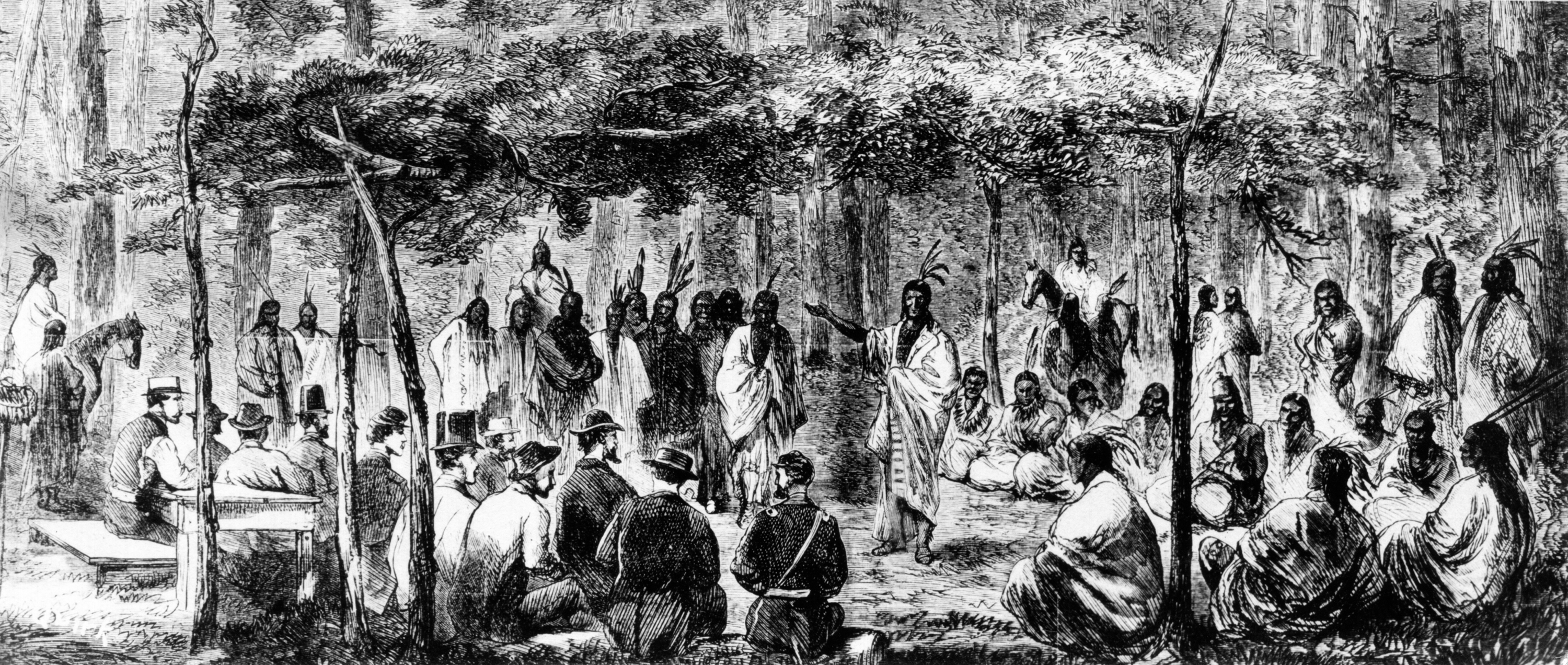The Encyclopedia of Oklahoma History and Culture
MEDICINE LODGE TREATY (1867).
In October 1867 a U.S. Indian Peace Commission signed three treaties at Medicine Lodge Creek near Medicine Lodge, Kansas. One treaty was made with the Kiowa and Comanche, a second confederated the Plains Apache with the Kiowa and Comanche, and a third was negotiated with the Arapaho and Cheyenne. The United States promised the tribes peace and protection from white intruders in return for amity and relocation to reservations in western Indian Territory. The Senate ratified the treaties in July 1868.
Post–Civil War America focused on westward expansion, sending migrants across the southern plains via the Santa Fe Trail. Increased contact between Americans and Plains Indians bred conflict as Americans encountered raiding, hunting, and captive-taking practices that were central to the Plains Indians' way of life. The United States intended the Medicine Lodge treaties to remove Indians from the path of American expansion, thereby avoiding costly wars.
The articles of the treaties defined reservation boundaries, the Indian agent's role, and the government's obligations to the tribes. The agent was charged to oversee reservation affairs, including construction of buildings, employee residences, and schoolhouses. He was also an agent of civilizing measures incorporated in the treaties. Annuity goods included clothes and implements for the building of an agrarian economy. A provision restricted off-reservation bison hunting to lands south of the Arkansas River. Rations, a de facto requirement for regional stability, were not mentioned. The tribes also promised to end hostility and objection to railroad construction and military posts. Article Twelve required approval of three-fourths of the adult male tribal population for future land cessions. Kiowa complaints that a 1900 allotment of reservation land without majority consent violated Article Twelve resulted in the landmark Supreme Court decision in Lone Wolf v. Hitchcock (1901).
Both the United States and the tribes failed to honor a number of articles in the treaties. The agreements became ensnared in a revolt unleashed by the House of Representatives against the Senate over the control of treaty making with American Indian nations. This conspicuously political quarrel produced the end of treaty making in 1871. Meanwhile, appropriations for Indian annuity goods and rations were delayed and wholly inadequate, producing starvation, sickness, and material deprivation among the tribes. The tribes continued raiding and taking captives outside their reservations in violation of the treaties, in part to resist the United States, in part to alleviate their starving conditions.
Learn More
Blue Clark, Lone Wolf v. Hitchcock: Treaty Rights and Indian Law at the End of the Nineteenth Century (2d ed.; Lincoln: University of Nebraska Press, 1999).
Douglas C. Jones, The Treaty of Medicine Lodge: The Story of the Great Treaty Council as Told by Eyewitnesses (Norman: University of Oklahoma Press, 1966).
Charles J. Kappler, comp. and ed., Indian Affairs: Laws and Treaties, Vol. 2, Treaties (Washington, D.C.: GPO, 1904).
James Mooney, Calendar History of the Kiowa Indians (Washington, D.C.: Smithsonian Institution Press, 1979).
Wilbur S. Nye, Carbine and Lance: The Story of Old Fort Sill (3d ed., rev.; Norman: University of Oklahoma Press, 1969).
Henry M. Stanley, "A British Journalist Reports the Medicine Lodge Peace Councils of 1867," Kansas Historical Quarterly 33 (Autumn 1967).
Citation
The following (as per The Chicago Manual of Style, 17th edition) is the preferred citation for articles:
Jacki Thompson Rand, “Medicine Lodge Treaty,” The Encyclopedia of Oklahoma History and Culture, https://www.okhistory.org/publications/enc/entry?entry=ME005.
Published January 15, 2010
© Oklahoma Historical Society


